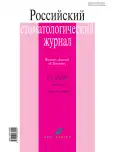Clinical and epidemiological features and medical and social characteristics of victims with injuries to the maxillofacial bones, according to the department of maxillofacial reconstructive plastic surgery of the national hospital of the ministry of health of the Kyrgyz Republic in 2010–2018
- Authors: Urgunaliev B.K.1, Yuldashev I.M.2, Rakhmanov A.T.3, Shayahmetov D.B.1
-
Affiliations:
- I.K. Аkhunbayev Kyrgyz state medical academy
- International higher school of medicine
- State educational institution of higher professional education “Kyrgyz-Russian Slavic University named after B.N. Yeltsin”
- Issue: Vol 24, No 2 (2020)
- Pages: 109-113
- Section: Organization of Healthcare Service
- URL: https://journals.rcsi.science/1728-2802/article/view/44700
- DOI: https://doi.org/10.17816/1728-2802-2020-24-2-109-113
- ID: 44700
Cite item
Abstract
Report. The authors studied the medical and social characteristics of victims with facial bone injuries based on archived data over a long period of time. It was found that the majority of patients were socially active, but not working men of young working age with secondary, higher or incomplete higher education. Most of them were permanent residents of rural areas. The most frequent injuries WERE domestic and seasonal (spring — autumn), which was due to an increase in the frequency of street injuries, as well as injuries sustained by rural residents during seasonal agricultural work, as well as an increase in the frequency of road accidents.
Analysis of the system of specialized medical care showed that most of the victims were hospitalized, bypassing the stage of clinical diagnosis and treatment, independently in the form of self-treatment.
A high frequency of delayed treatment and hospitalization of victims in medical institutions was found, which was associated with the remoteness of the place of permanent residence, material problems, inadequate outpatient treatment at the place of residence , as well as diagnostic errors at the pre-hospital stage.
Full Text
##article.viewOnOriginalSite##About the authors
Bakyt Kubanychbekovich Urgunaliev
I.K. Аkhunbayev Kyrgyz state medical academy
Author for correspondence.
Email: urgunaliev@yandex.ru
Candidate of Medical Sciences
Kyrgyzstan, BishkekI. M. Yuldashev
International higher school of medicine
Email: urgunaliev@yandex.ru
Kyrgyzstan, Bishkek
A. T. Rakhmanov
State educational institution of higher professional education“Kyrgyz-Russian Slavic University named after B.N. Yeltsin”
Email: urgunaliev@yandex.ru
Kyrgyzstan, Bishkek
D. B. Shayahmetov
I.K. Аkhunbayev Kyrgyz state medical academy
Email: urgunaliev@yandex.ru
Kyrgyzstan, Bishkek
References
- Afanasiev V.V. Surgical dentistry: Textbook. Moscow: GEOTAR-Media; 2010. (in Russian)
- Aladelusi T., Akinmoladun V., Olusanya А., et al. Analysis of Road Traffic Crashes-Related Maxillofacial Injuries Severity and Concomitant Injuries in 201 Patients Seen at the UCH, Ibadan. Craniomaxillofac Trauma Reconstr. 2014; 7(4): 284‒9.
- Kopetsky I. S. Severe craniofascial trauma. Nauka Krasnoyar'ya. 2012; 3(3): 89–101. (in Russian)
- Levenets A.A., Gorbach N.A., Focas N.N. Maxillofacial traumatism as a social, economic and medical problem. Sibirskoe meditsinskoe obozrenie. 2013; 80(2): 13‒8. (in Russian)
- Anderson P., Yong R., Surman T., et al. Application of threedimensional computed tomography in craniofacial clinical practice and research. Aust Dent. J. 2014; 4(1): 174‒85.
- Maday D.Yu., Shcherbuk A.Yu., Absava K.A., et al. Strategy for providing specialized medical care to victims with craniofacial trauma in the trauma center of the first level. Vrach-aspi-rant. 2013; 61(6.1): 126‒32.
- Babkina T.M., Demidova E.A. Modern approaches to the diagnosis of injuries of the maxillofacial region. Luchevaya diagnostika i terapiya. 2013; 4 (4): 66–72. (in Russian)
- Broyles J.M., Wallner C., Borsuk D.E., et al. The role of computerassisted design and modeling in an edentulous mandibular malunion recon-struction. J. Craniofac. Surg. 2013; 24(5): 1835–8.
- Tsao K., Cheng A., Goss A., Donovan D.J. The use of cone beam computed tomography in the postoperative assessment of orbital wall fracture reconstruction. J. Craniofacial Surg. 2014; 25(4): 1150‒4.
- Yuldashev I.M., Urgunaliev B.K., Ashinaliev A.A., Moldaliev E.K., Yuldasheva D.T., Kasenova N.S. Total odontogenic mediastinitis as a complication of putrefactive-necrotic phlegmon of the oral floor. Tikhookeanskiy meditsinskiy zhurnal. 2011; 3: 97‒8. (in Russian).
Supplementary files








